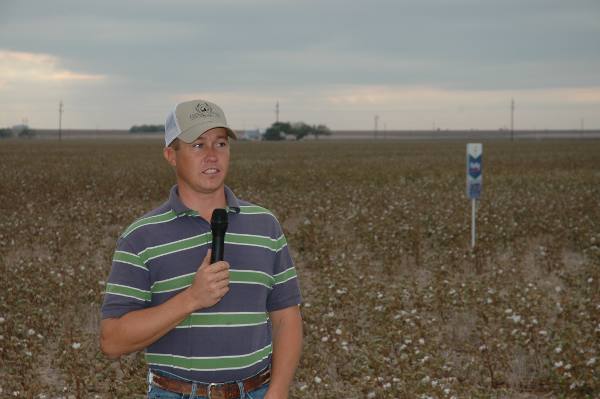
A little bit of rain and a no-till planting system that helps hold moisture made a difference this summer.Except for 1.4 inches of rain in May and that 2/10-inch shower in June, the area had no appreciable rainfall since late July, 2010.Reduced tillage has become more popular in the area over the past few years.

Paul Minzenmayer will make a dryland cotton crop. It won’t come close to his average production, but a little bit of rain and a no-till planting system that helps hold moisture made a difference this summer.
Minzenmayer talked about crop prospects at a recent Runnels County, Texas, turn-row meeting where nearby farmers and other industry representatives came to look at variety trials and hear updates on drought conditions, disease control options and other cotton and small grain issues.
A planting-time rain gave Minzenmayer’s cotton enough moisture to germinate and he got another two-tenths inch on June 20. A 2-inch rain in late August was too late to help, and a mid-September rainfall did no more than delay harvest for a day or two.
Except for 1.4 inches of rain in May and that 2/10-inch shower in June, the area had no appreciable rainfall since late July, 2010. “We got no rain over the winter,” Minzenmayer says.
He expects to average about 150 pounds of cotton per acre.
That’s less than the usual Runnels County average, which typically runs from 200 to 250 pounds per acre, according to AgriLife Extension agent Marty Gibbs.
“But Paul will make better than that,” Gibbs says. ‘He’s usually closer to 400 pounds to a bale-per acre.”
“I typically plant behind wheat,” Minzenmayer says. He prefers to plant cotton behind two years of wheat.
“I rotate to help reduce root rot damage,” he says, “but mainly because cotton just does so much better behind a wheat crop.”
He plants reduced-tillage into the wheat stubble. He’s convinced that the organic matter and cover he gets from wheat stubble played a role in his ability to make a dryland crop this year. “The reduced till helps hold moisture,” he says.
He has no irrigated cotton. “I just started stripping cotton,” he says. ‘It’s not going to make much.”
He had little insect pressure this summer. “I didn’t spray for bugs, and I didn’t fertilize,” he says.
But he will make some dryland cotton when most fields have long been abandoned.
“We have very few irrigated fields in the county,” Gibbs says. “And most of the county’s cotton fields will make little, if any cotton. ‘We have a few green spots but not many.”
He says reduced tillage has become more popular in the area over the past few years. ‘We have a lot of different reduced-till systems,” he says. ‘Most farmers are trying to cut back on trips cross the fields. Probably 40 percent of our cotton is now in some reduced tillage program.”
Even with reduced tillage and low input costs, Gibbs expects farmers to have a hard time making a profit with expected yields this year. Even minimum till operator have weed control costs, planting, seed, tech fees, boll weevil assessment, insurance premiums, harvesting, labor and ginning fees. It’s hard to get all that covered with a 150-pound yield,” he says.
Gibbs doesn’t expect cotton acreage to fall off next year, despite a disaster this year.
“Cotton is one of our best safety nets, and it has a good insurance program. We’re also set up to grow cotton in Runnels County, and we have the infrastructure to support it.’
Wheat acreage, however, likely will be down as farmers balk at planting into dry soils this fall.
“I already see folks pulling back,” Gibbs says. “We usually have a lot of wheat for grazing and a good bit for dual purpose. We usually have 100,000 to 110,000 acres of wheat and from 50,000 to 55,000 acres of cotton.”
He thinks cotton will take some of the wheat acreage.
Minzenmayer is holding off for as long as possible to seed wheat this fall. “I’ll wait a little longer for a rain,” he says. “But I need to plant within a week or two for grazing. I’ll wait until October to plant for grain.”
He expects to make no significant changes to his production system next year. “I’ll stick with two years of wheat and one year of cotton and minimum till,” he says.
About the Author(s)
You May Also Like





